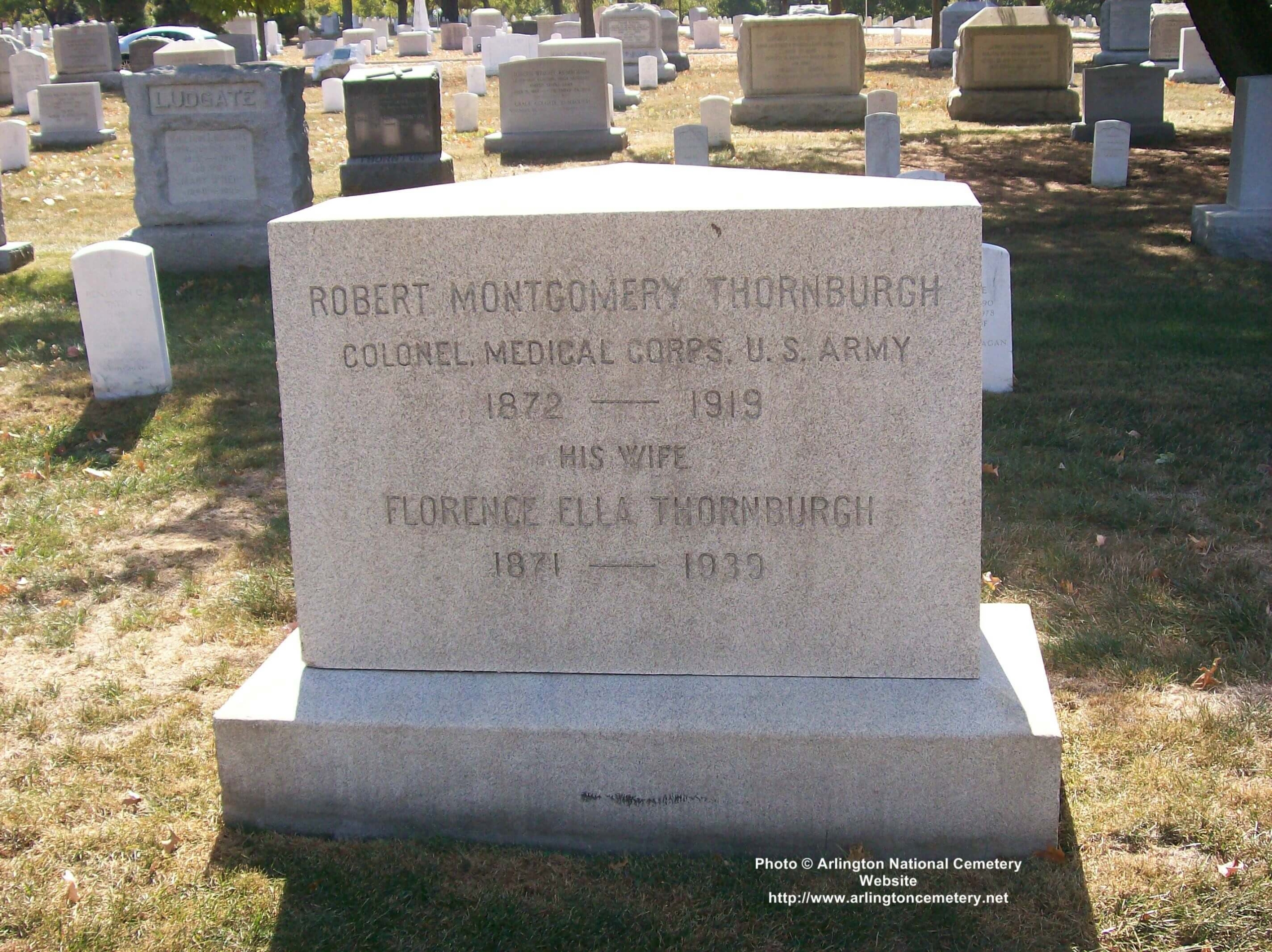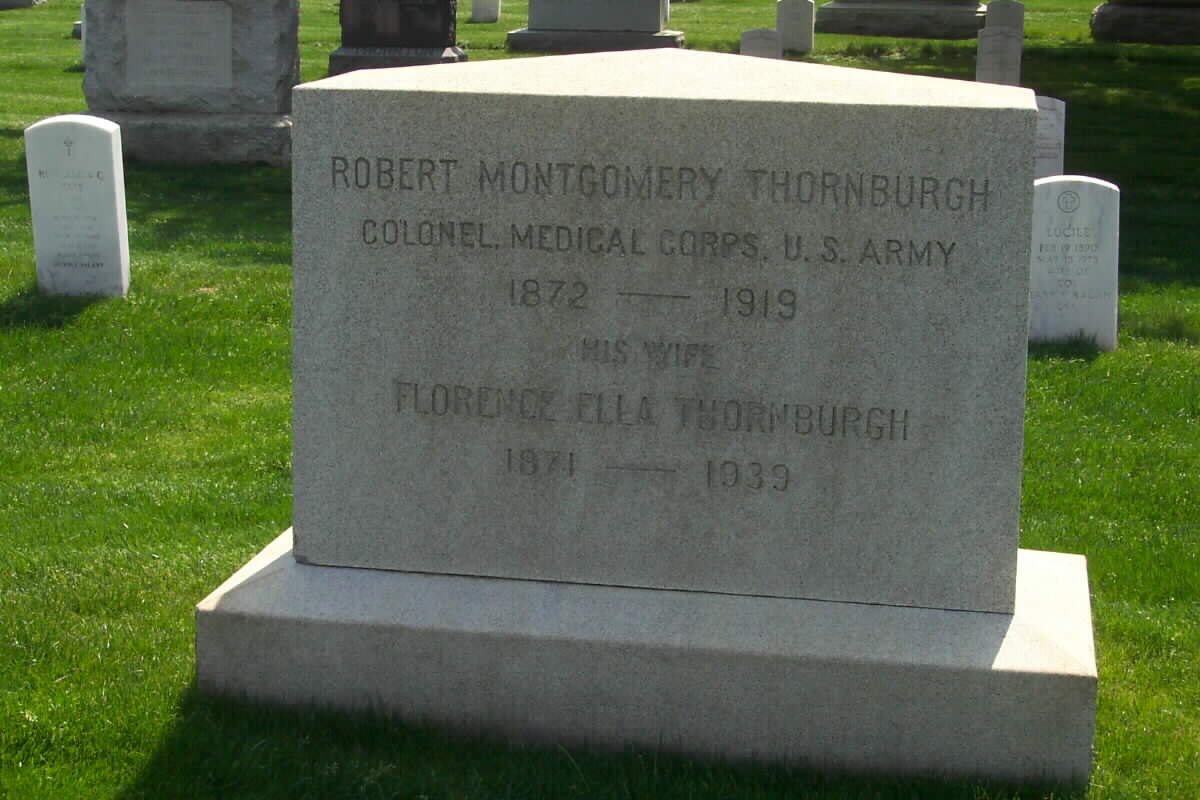Listed as Lieutenant, United States Army, died 9 October 1919. Buried in Arlington National Cemetery, Section 3, Grave 1517.
Thomas Tipton Thornburgh was born in 1843 in New Market, Tennessee. He had married Eliza Jane Clark and they were the parents of one son, Robert Montgomery Thornburgh. Major Thornburgh was in charge of a fort in Rio Blanco County, Colorado near where the “Thornburgh Massacre” occurred on the White River Indian Agency.
Born 13 March 1872 at Omaha, Douglas County, Nebraska, the son of Thomas Tipton Thornburgh and Eliza Wilson Clark Thornburgh. Married to Florence E. Carroll 28 April 1895
Street names at the Presidio read like a history of the old post. Edie Road was named for Colonel Guy L. Edie who served as the Commanding Officer of Letterman Hospital during World War I. Kendall Road was named for Major William P. Kendall, the Commanding Officer of Letterman Hospital from 1901 to 1904. During his administration the original hospital was built. Thornburgh Road was named for Colonel Robert M. Thornburgh, the Commanding Officer of Letterman in 1919. He served in the Philippines, Mexico, and France. Gorgas Avenue was named for Colonel William Gorgas, the Chief Sanitary Officer of the Panama Canal Commission from 1904 to 1913. Through mosquito control, he suppressed yellow fever and made the canal’s completion possible.
Courtesy of the Thornburgh Family Newsletter:
Robert M. Thornburgh caught my attention, so I checked with the folks at Dartmouth to see if they had any information or details they could share about him. That turned into a gold mine!
Some of the most interesting details about Robert:
His father Thomas Tipton Thornburgh was a Major in the regular army, and was killed in an Indian massacre. From 1908 to 1910 he served at the military prison, Alcatraz Island, San Fransisco. 1916 For two months was the temporary Chief of Surgical Staff at Walter Reed Hospital, Washington. Through his military carrer, was stationed in The Philippines, France, China and Mexico. His only son Thomas T. Thornburgh was a West Point graduate. He died when the car he was riding in collided with a bus. Supreme Justice Henry A. Melvin delivered a short address at his funeral. Buried in Arlington National Cemetery.
The info from the college says that Thomas T. Thornburgh (the son) was fifth generation army. My notes confirm that his great grandfather Montgomery Thornburgh died in Andersonville Prison during the Civil War. The fifth generation, would have been Ai Thornburgh, but I have no information about his military service.
There was one name that showed up in every volume. It was Robert M Thornburgh. According to these registers, he graduated from Dartmouth Medical School in 1897 and joined the Army Medical Core in 1901. He was in the Army until 1919 when he was listed as a casualty. His progress through the ranks looks like:
In Permanent Establishment In Federal Service other than the Permanent Establishment
Assistant Surgeon 1901 Colonial Medical Corps, N.A. December 1917
Captain Medical Corps, 1906
Major, 1910
Lieutenant Colonel, 1917
In the 1918 Register we also find:
Thomas T. Thornburgh Cadet 1916 Born in New Hampshire August 15, 1896
Second Lieutenant of the Cavalry 1918
In the 1920 Register:
Thomas T. Thornburgh as above with the additional note:
Assigned to 16th Cavalry February 12, 1919
THORNBURGH, ROBERT M
COL MED CORPS US ARMY
- VETERAN SERVICE DATES: Unknown
- DATE OF DEATH: 10/09/1919
- DATE OF INTERMENT: Unknown
- BURIED AT: SECTION SS SITE 1517
ARLINGTON NATIONAL CEMETERY
THORNBURGH, FLORENCE E W/O ROBERT M
- DATE OF DEATH: 07/10/1939
- DATE OF INTERMENT: 07/21/1939
- BURIED AT: SECTION SOU SITE 1517
ARLINGTON NATIONAL CEMETERY - WIFE OF ROBERT M. THORNBURGH
COL MEDICAL CORPS USA
Michael Robert Patterson was born in Arlington and is the son of a former officer of the US Army. So it was no wonder that sooner or later his interests drew him to American history and especially to American military history. Many of his articles can be found on renowned portals like the New York Times, Washingtonpost or Wikipedia.
Reviewed by: Michael Howard


